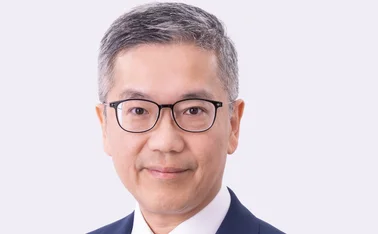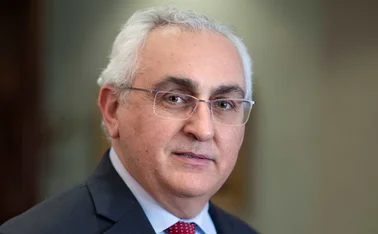
Paul Volcker, 1927–2019
Fed chair made his name battling inflation, and left his mark on independence and post-crisis financial regulations

Paul Volcker, scourge of inflation, died on December 8, 2019, aged 92. He was an academic and a commercial financier as well as a long-standing public policy official. But it was as chair of the US Federal Reserve Board from 1979–1987 that he made history. It was a time of great monetary instability, as the world was still reeling from the collapse of the Bretton Woods system. In 1980, inflation in the US hit 14.8%. It would take bitter medicine to bring it back down, which Volcker delivered. He viewed public office as a precious trust, and established a benchmark for integrity, dedication and commitment in public service. He demonstrated that inflation could be kept under control and that central banks could encourage fiscal discipline. Moreover, he did this while keeping a close eye on financial markets and the banking system. Although he was an economist, he did not sit in an ivory tower. In a statement shared with Central Banking, Alan Greenspan, who succeeded Volcker as chair, said simply: “Paul Volcker was the most effective chairman in the history of the Federal Reserve.”
Born in Cape May, New Jersey, Volcker gained his bachelor’s degree from Princeton University. He followed it up – after a summer internship at the Federal Reserve Bank of New York – with a master’s degree in public administration from Harvard. He served as a Fed economist from 1952 to 1957, before moving to Chase Manhattan Bank for a spell. In 1962, he took a job as director of the Treasury’s Office of Financial Analysis. In 1965, he returned to Chase Manhattan as vice-president, then in 1969 he went back to the Treasury as undersecretary for monetary affairs, just as Bretton Woods was teetering on the brink. Volcker’s role put him at the heart of the effort to save the system. He was a believer in the value of fixed exchange rates, but he well understood the tension posed by US spending on the Vietnam war and the limited supply of gold. All the same, he rejected the option favoured by many Europeans of raising the price of gold. He argued it would reward speculators, and, besides, it required Congressional approval, which did not appear to be forthcoming. Volcker came to the view that it was necessary to revalue other currencies against the dollar to save the overstretched peg. He pushed president Richard Nixon for a “cold-blooded suspension” of gold convertibility, designed as a temporary measure to force Europeans’ hands. But ultimately, the suspension in 1971 marked the end. Bretton Woods was never restored to health.
In 1974, Volcker left the Treasury to return to Princeton, and shortly after, he was named president of the New York Fed. The role gave him a direct say in monetary policy-making and control over the Fed’s market operations.
Paul Volcker was the most effective chairman in the history of the Federal Reserve Alan Greenspan
Alan Greenspan
“At the New York Fed, he was known as ‘Tall Paul’, and for many he was a remote figure who was hidden behind cigar smoke, spoke with a mumble and seemed to stare out to a distant point in mid-discussion. Conversations could end abruptly, with an ‘OK’ and head turned away – no ‘thank you’, ‘see you later’ or other traditional wrap-up,” recounts Peter Bakstansky, senior spokesman and head of public information at the New York Fed from 1976–2006. “But for those of us who worked with him daily, we understood his innate shyness, warmth, sly sense of humour and deep commitment to policy. He also instilled an ethos of integrity for the institution and a spirit of teamwork that did not reward individual attention seekers or organisational climbers.”

At six feet seven inches, Volcker was also starting to stand out as an advocate of monetary restraint at a time when the Fed was rapidly losing control of inflation. In his book, Keeping at it, Volcker said he had become increasingly concerned about monetary policy being overly easy during his time in New York. He was pressed by some regional Fed presidents to voice his concerns more strongly and started to do so after Arthur Burns (who hired Volcker) was replaced by William Miller as Fed chair in 1978. This was the same year, after a run on the US dollar that October, that Volcker learned floating currency rates do not necessarily bring about an end to currency crises. In 1979, prices in the US were rising by an annualised 14%, in part driven by the second oil crisis.
When Miller transferred to become president Jimmy Carter’s Treasury secretary, creating a vacancy at the Fed, Volcker said he got “a surprise call” from Miller asking him to come to Washington, DC. While digging through his papers in recent years, Volcker said he found an old ‘note to self’, listing the three points he wanted to raise at the meeting: the need for the independence of the Fed; that the Fed had to deal with inflation head-on; and that it would require tighter policies than under Miller. Volcker told friends he thought he had blown his chances, but received a call from Carter informing him he had got the job. Less than a week after his July 25 nomination, Volcker had a Senate hearing, and on August 6 (indicating things used to happen faster than today), was sworn into office as Fed chairman, taking a cut in pay from $110,000 to $57,500.
Volcker, who was famously frugal, appeared to cope with the cut in salary. He smoked cheap cigars and lived in an apartment with students from George Washington University while he in Washington, DC. His daughter helped him with his laundry. He also stood by a rule that he should always pay his own way. Former Bank of England (BoE) governor Mervyn King recalls accepting a US dollar cheque from Volcker when he insisted on paying for a dinner in the UK. And Bakstansky recalls Volcker threatening to leave a conference hotel in the middle of a cold winter night unless he could pay for his own room: high standards needed to be maintained at all times.
Ready for radical action
Chairing a September 18 Federal Open Market Committee meeting in 1979, Volcker secured a 4:3 majority supporting an increase in the loan rate to banks to 11% – the board’s third tightening action in little over a month. He viewed the vote as an important victory. But instead of a favourable market reaction, Volcker received an important lesson about sentiment and market psychology. Market participants saw things differently. They perceived a divided FOMC, and questioned the Fed’s commitment to tackling inflation. They viewed Fed actions as too little, too late, and too divided to influence expectations.

It was at this time that the debate at the Fed started to centre on the need to take control of the quantity of money (the money supply) by restricting commercial bank reserves held at the Fed, rather than focusing on the price of money (the interest rate). A number of regional Fed presidents had favoured controlling the quantity of money, and Volcker was soon to back what he termed “practical monetarism”, where the quantity of money was a factor in decision-making, rather than Milton Friedman’s “mechanistic monetarism”, which involved a hard quantity of money rule.
Before leaving for the International Monetary Fund/World Bank’s annual meeting in Belgrade in October 1979, Volcker charged two Fed officials – Peter Sternlight, who then ran the trading desk in New York, and Stephen Axilrod, who managed the execution of monetary policy – to prepare a new approach, “directed emphatically toward restraining the growth of money, rather than toward setting some perceived appropriate level of interest rates”, according to Volcker.
Lashed to the mast
Volcker hinted at the new approach to Deutsche Bundesbank president Otmar Emminger (who helped to develop special drawing rights) on a plane journey to Belgrade after Volcker’s stopover in West Germany to speak with then-chancellor Helmut Schmidt. Volcker stayed on at the IMF meeting to listen to Arthur Burns’s Per Jacobsson Lecture, in which he (infamously) expressed doubt that central banks were even capable of controlling inflation any more, before flying back early to Washington, DC. Shortly after, Volcker held an extraordinary meeting of the FOMC, where he noted that even the more dovish members were inclined towards “greater certainty in decisions” because of market turmoil. Volcker’s Fed proposed a one percentage point cut in the discount rate to 12%, banks being required to put aside more deposits as reserves, an end to lending for speculative activities and – most importantly – a commitment to restrain growth in the money supply, whatever the implications might be for interest rates.

Volcker had hoped long-term rates would not rise as sharply as short-term rates. “No such luck,” he said in his memoir. At first, inflation continued rising. As the economy slid into recession, Volcker came under intense pressure to reverse course. Famously, the Fed was blockaded by tractors driven by irate farmers. And Volcker received ‘two-by-four’ planks of wood in the post from construction workers (Ben Bernanke has said he kept a plank in the chair’s office during his term as a reminder), who said they no longer had any need for them – there was no work to be had. Volcker said Friedman and other monetarists also failed to offer any support – the Fed’s actions were the ‘wrong sort’ of monetarism. But the Fed did not lose its nerve, despite rates exceeding the upper limits of the FOMC’s expectations on a number of occasions. Ultimately, Treasury bills exceeded 17%, the commercial bank prime lending rate peaked at 21.5% and mortgage rates exceeded 18%.
Unanticipated consequences
In the early 1980s, Volcker learned another important lesson. The Carter administration, with an eye on forthcoming elections, proposed new credit controls to support monetary tightening. “It was a transparently political ploy. We didn’t want to do it,” said Volcker. “We quickly designed ‘controls’ that we hoped would lack real teeth.”
But the policy had an unanticipated problem: many Americans decided to cut up their credit cards to support the initiative, resulting in a fall in bank deposits and the money supply. This resulted in the Fed unwinding the controls, which coincided with a strong increase in the money supply, forcing the Fed to raise the discount rate to 11%. Volcker said the experience taught him about the unanticipated consequences that regulatory controls – “even weak ones” – could have on the economy, adding that this mistake cost the US six months, and failed to help Carter’s campaign for a second term. “To his credit, only once did he express concern about our tightening of policy,” said Volcker.
Inflation vanquished
With Ronald Reagan moving into the White House and a recession in 1981, Burns warned Volcker of an effort to rein in the Fed. Meanwhile, another group wanted a return to the gold standard. By 1982, with interest rates at 15% and the money supply still high, Volcker himself was concerned. But the inflation rate finally started to come down, hitting 4% that year. It was at this point that the decision was taken to abandon targeting the money supply and end interest rate controls on bank deposits. Volcker said that the money supply measures M1a, M1b, M2, M3 had diverged and that at the October FOMC meeting it was clear that “inflation had come under control”, but that money supply signals were “erratic and unreliable”. Reflecting on the period in hindsight, Volcker said he was not aware that interest rates would rise as high as they did, but when asked if there was a better path to success, he replied: “Not to my knowledge – not then or now.”
Otmar Issing, the first chief economist at the ECB, describes Volcker’s inflation-fighting credentials as “legendary”: “He was the central banker with the highest reputation in the world, which showed also respect for his honest personality”
Speaking to Central Banking, Otmar Issing, the first chief economist at the European Central Bank, describes Volcker’s inflation-fighting credentials as “legendary”: “He was the central banker with the highest reputation in the world, which showed also respect for his honest personality.”
Former IMF managing director Jacques de Larosière adds: “In 1979–80, he was the only one able to break inflation, which was overwhelming at the time, and to take full responsibility for his actions. And he won.”
An honest broker
Volcker’s reputation for integrity and honesty meant he was frequently asked to act as an ‘honest broker’. Whether it was negotiating with the United Automobile Worker chief Doug Fraser in 1979 during the Chrysler Corporation bailout or acting as chairman of the Independent Committee of Eminent Persons in 1996 to investigate the Swiss bank accounts of victims of Nazi persecution that had lain dormant or had not been made available to those victims, Volcker was sought out for his impartiality.
He was also a role model.
Thomas Hoenig, former vice-chair of the Federal Deposit Insurance Corporation (FDIC) and president of the Federal Reserve Bank of Kansas City from 1991–2011, said Volcker demonstrated great “courage and conviction” throughout his career, adding he was “enormously respectful” to Fed staff: “He was a true role model for me: a dedicated public servant of the highest integrity.”
Volcker’s impact was also felt by policy-makers outside the US. YV Reddy, former governor of the Reserve Bank of India, recalled how Volcker spoke at length about his views on global development and his support for tight monetary policy measures to contain inflation and strict prudential norms for restraining excessive credit growth in India at a dinner in Mumbai. “His articulation lent support to my efforts by strengthening public opinion in my favour – his credibility in the world of money, finance as well as the government in India also, was evident to me at that time,” Reddy told Central Banking in 2014.
Political interference
Even as the US economy recovered and Volcker’s reputation soared, pressure remained. Still, the Fed’s independence to set monetary policy was “challenged only once” in Volcker’s direct experience, in what he described as a “striking reminder about the pressure that politics can exert on the Fed as elections approach”. This was in 1984, when Volcker was summoned to a meeting with President Reagan at the White House. The meeting “strangely” did not take place in the Oval Office, but in the “more informal library”, said Volcker. “As I arrived, the president, sitting there with chief of staff Jim Baker” – someone Volcker would spar with in subsequent years – “seemed a bit uncomfortable. He [Reagan] didn’t say a word,” he recounted. “Instead, Baker delivered a message: ‘The president is ordering you not to raise interest rates before the election.’”
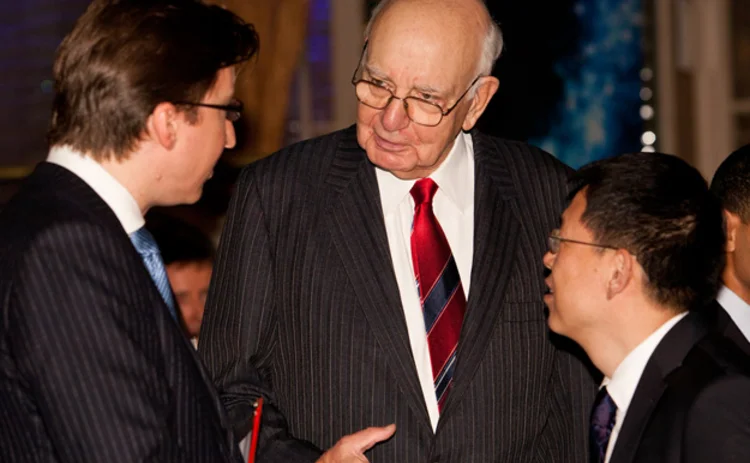
Volcker said he was “stunned”: “Not only was the president clearly overstepping his authority by giving an order to the Fed, but also it was disconcerting because I wasn’t planning tighter monetary policy at the time.” Volcker wondered to himself what he should say or do: “I walked out without saying a word.”
The international monetary system
A strong dollar – it rose 50% against the currencies of the next four major trading nations of Japan, Germany, the UK and France from 1980–84 – resulted in a major intervention by the Bundesbank in 1984 to support the Deutschmark. But its interventions were made on its own without US support, despite Volcker’s entreaties to Don Regan at the US Treasury to join in. Things changed the following year, when Baker took over as Treasury secretary. Baker believed the value of the dollar was too high, and sought a depreciation followed by the introduction of ‘targeted zones’ for major currencies, to maintain a degree of stability among major currencies consistent with competitive balance.
Baker first started to explore the option of creating an explicit agreement among the Group of Five nations to actively depreciate the dollar. The G5 met in New York’s Plaza Hotel, and hammered out the so-called Plaza Accord to manipulate exchange rates by depreciating the US dollar relative to the yen and the Deutschmark.
By this stage, Volcker himself felt the dollar’s strength was already past its peak. “I wasn’t enthused, to say the least, about giving it a strong, officially sponsored downward shove at the risk of setting off an accelerating speculative slide,” he said.
The following year, at a meeting in London, Volcker was presented with a G5 draft communiqué that also hinted at co-ordinated monetary easing. But he and Bundesbank president Karl Otto Pöhl objected to the draft comments on monetary policy, which were subsequently removed.
Revolt at the Fed
Volcker said it was possible that his refusal to accept the communiqué’s language may have embarrassed Baker in front of his peers, but he had no firm evidence of this. However, shortly after, he faced down a major revolt at the Fed. Preston Martin, the former head of the Federal Home Loan Bank Board, who apparently knew Reagan when he was governor of California, was appointed to succeed Fred Schultz as vice-chair at the Fed in 1982. Volcker said things worked well for a couple of years, but he then started to notice “unusual behaviour” by Martin: trips abroad and in the US without informing the Fed chair; dissenting votes without prior warning; and a public speech second-guessing the Latin American debt strategy agreed by the Fed board. Volcker issued a public reprimand.
Things came to a head at a non-voting meeting of the Fed board in February 1986, when Martin made an “out-of-the-blue proposal” to cut the Federal Reserve’s discount rate, and Volcker said his request to hold off discussions until a normal policy day later that week were ignored. Board members Manuel Johnson and Wayne Angell, plus frequent dissenter Martha Seger, joined with Martin seeking a cut there and then. Volcker left the meeting and told Baker he planned to resign. Angell later approached Volcker requesting a second vote, to which Martin agreed. “The vote was reversed with my promise that we would go ahead when and if I could reach agreement with the Bundesbank’s Karl Otto Pöhl and Japanese central banker Satoshi Sumita to act together, as I had been urging,” said Volcker.
Co-ordinated easing
In early March that year, the major central banks co-ordinated their monetary policy, and Martin resigned soon after. The episode contributed to Volcker staying on to the end of his term (he had planned to leave early). As a result, he was still at the Fed when Baker began exploring the possibility for a framework stabilising the exchange rates of the G5 currencies at close to their end-of-1986 levels. Volcker supported exchange rate stability in a world of free capital flows, something the creation of the euro would be a step towards. But Baker’s Treasury made little effort to gain Fed support ahead of a G5 meeting at the Palais du Louvre. An unannounced agreement was reached on exchange rate bands of plus or minus 2.5% that apparently would be supported by fiscal and monetary policy. At first, the currencies behaved well, trading within their bands, but soon the dollar slipped below its band. In one of his last decisions, Volcker resolved not to increase the Fed discount rates – even though it had room to: “I decided not to force the issue, keeping our powder dry. So, we made just a small nudge to the market towards restraint.”
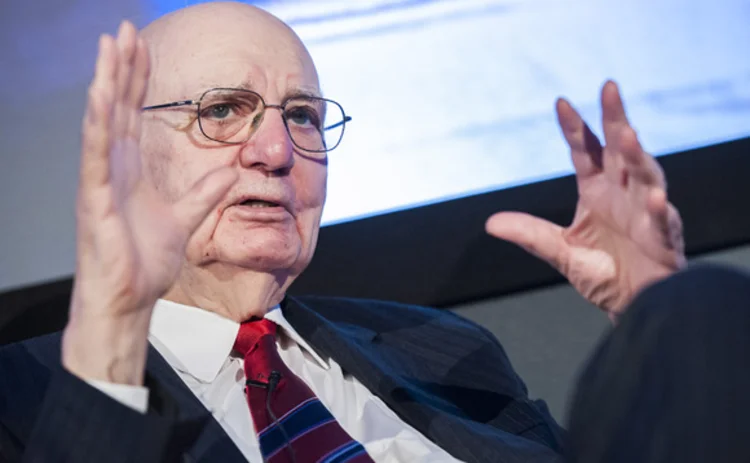
Volcker left the Fed on August 11, 1987, by which time the exchange rate bands had become nonoperative. “The strong written commitment to complementary fiscal and monetary policy was absent,” said Volcker. “The essential riddle of international monetary reform remained unresolved.”
Advocate for reform
Despite the shift to a ‘non-system’, however, Volcker continued to advocate for monetary reform. In 1995, he called for a system where the US dollar would roughly equal 100 yen and the future euro potentially at parity to the US dollar at a later stage. Volcker recalled BoE governor Eddie George whispering to him: “Nice speech, but it won’t happen.” George was correct. Speaking to Central Banking journal in 1999, Volcker defended central bank independence, and set out a vision of the international economy that more or less came true: “In the future, we will have two big regional currencies – the US dollar and the euro. There are many inhibitions to the yen playing the same role. I would not be surprised if the Chinese renminbi were to become the dominant currency in Asia.”
Volcker’s last effort to develop the outline for comprehensive monetary reform took place in the aftermath of the global financial crisis. The effort, called the ‘Palais-Royal initiative’, was led by Michel Camdessus, Alexandre Lamfalussy and Tommaso Padoa-Schioppa. But the former Fed chair lamented that it was “little noticed”, with the report “lost” amid “the pressing concerns” of the European sovereign and bank debt crisis in 2011.
That marked an end to Volcker’s major public interventions. But it did not mean he felt less passionately about it. “There has been little attention to whether we have an international monetary system that makes sense in today’s world. I am one of the few people worried about this,” he told central bankers gathered for the Central Banking Awards dinner in 2014. “We have not learned how to live with volatile capital flows that will respond to small, almost insignificant, changes in terms of big countries, but which are very upsetting for small countries and small markets.”
Banking bailouts
Volcker was also at the Fed when the term ‘too big to fail’ entered popular parlance. Ever since the Great Depression, US banks had remained relatively stable, making modest returns, with equity capital in the region of 10%. But the rise of money market funds offering higher yields and a move towards leveraged buyouts, combined with a flood of fund inflows of Middle Eastern oil money, contributed to banks lending injudiciously to Latin America and elsewhere.

In 1984, the Fed had agreed to offer discount window access to Continental Illinois, an important bank for the Midwest’s economy. The move was part of an effort to support the Chicago-based bank, which got into trouble by buying speculative loans to oil developers from another troubled bank, Penn Square. As part of a workout, the FDIC had agreed to a capital injection of $2 billion in the form of subordinated debt. But FDIC chair Bill Isaac wanted major banks to take on another $500 million of subordinated debt as part of the effort to restore the bank’s finances. The banks were wary of this, as they had already extended a credit line of $4.5 billion to their competitor. While Volcker left the secret negotiations to make a pre-planned speech, Isaac decided to extend FDIC guarantees to all the bank’s creditors, which duly took the $500 million in subordinated debt and increased their credit lines to $5.5 billion. The deal represented only a temporary reprieve for Continental Illinois, but reinforced the sense that some banks were simply too big to be allowed to fail.
Volcker was also present at the Fed during the savings and loan associations (S&Ls) fiasco – although the Fed had no direct oversight responsibility for these entities. S&Ls paid higher deposits than banks, and funded longer-dated, fixed-rate mortgages. High inflation and interest rates, coupled with banks being permitted to compete more aggressively for deposits, resulted in depleted earnings and capital, although regulatory forbearance allowed many S&Ls to survive into the 1980s. The S&Ls ultimately expanded into commercial lending in a bid to reverse their fortunes, with most failing to do so, leading to a bailout of around $150 billion.
Latam debt crisis
Too big, or too interconnected, to fail resurfaced in the form of the Latin American debt crisis, when major international lenders, flush with money from the newly oil-rich Middle East, had made extensive loans to less developed countries. Many of these countries were running excessive deficits funded by petrodollar recycling, and they struggled to make payments on their debts. Ultimately, banks started to cut their lending in Mexico in 1982, and Volcker had to call off another one of his regular fishing trips to structure a response. The Fed offered a $600 million swap agreement to help bolster Mexican reserves.
Despite US intervention, Mexico ran out of money in August that year. IMF managing director de Larosière warned that a Mexican default would trigger a major banking crisis. The US made advance payments for oil imports, and offered financial support for agricultural exports. At a meeting convened at the New York Fed, a creditors’ committee was set up, led by Citibank’s Bill Rhodes. Volcker played a key role in securing central bank support for Mexico, backed up by the BoE’s Gordon Richardson and the Swiss National Bank’s Fritz Leutwiler. De Larosière made IMF support for rolling over existing debt and the extension of new loans conditional on a stringent reform programme for Mexico and a ‘critical mass’ of creditors agreeing to participate in the debt restructuring. The plan was replicated throughout Latin America.
Basel Accord
Volcker was also involved in the effort to establish capital rules for internationally active banks – the Basel Capital Accord. Creating a level playing field was viewed as important in the US, particularly as Japan’s large banks were seen as operating with less capital than their peers elsewhere. But there were different perspectives when it came to capital. The US tended to favour leverage ratios, while the Europeans preferred risk-based capital, including holdings of domestic government bonds and mortgage debt that required no or limited capital.
Volcker described in Keeping at it how he persuaded BoE governor Robin Leigh-Pemberton to agree on a bilateral understanding between the UK and US on bank capital in 1987. New York Fed president Gerry Corrigan then set out to secure Japanese agreement and, ultimately, that of continental Europe. The Basel Committee on Banking Supervision, which Volcker said was “bypassed because of its reluctant posture”, was “delegated the task of writing the final rules later that year”. Volcker praised the hybrid approach of Basel III, which includes strict leverage ratios in addition to risk-based capital charges, but noted that the rules “began to be diluted” less than a decade after the 2008 crisis.
The Volcker rule
The debate around ‘too big to fail’ resurfaced at the height of the global crisis, when the systemic importance of US financial institutions resulted in their need to be bailed out using taxpayer funds. As an adviser to president Barack Obama, Volcker headed the Economic Recovery Advisory Board, and helped the Obama administration develop the Dodd-Frank legislation in 2010 to try to address the issue.
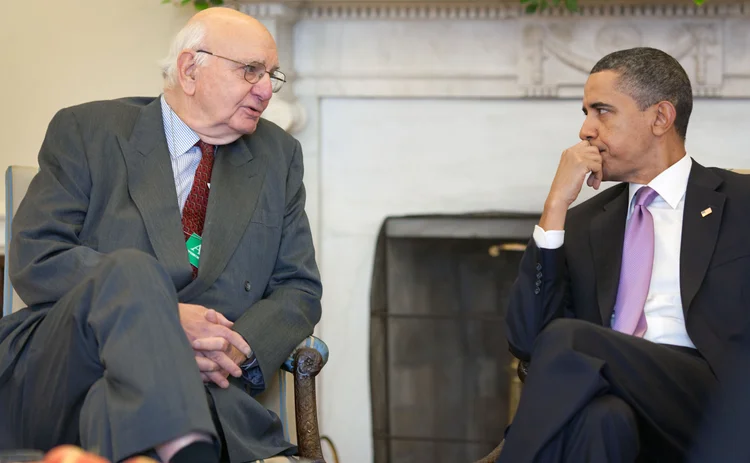
“In my view, [it] goes a long way towards creating an effective resolution process for failing banks,” said Volcker. “While inherently complicated and necessarily a matter of international concern, it requires removing management of a failing bank and, if necessary, liquidating or reorganising the bank at the expense of stockholders and creditors instead of taxpayers.”
Indeed, Volcker has left an enduring legacy from this work, and lent his name to a key provision of the Dodd-Frank Act, the Volcker rule, which separates banks’ proprietary trading from their retail operations. Volcker testified to politicians worldwide on the approach, and elements of the idea were adopted elsewhere.
Triumph of central banking?
Volcker’s persistence and courage to beat back inflation helped to restore the credibility of central banks around the world, and contributed to insulating them from partisan politics. Former chair Bernanke told The New York Times: “He came to represent independence. He personified the idea of doing something politically unpopular, but economically necessary.” Indeed, Volcker’s Per Jacobsson Lecture in 1990 was called ‘The triumph of central banking?’, with conclusions in stark contrast to Arthur Burns’s ‘The anguish of central banking’ lecture, which Volcker had listened to 21 years earlier.
But the question mark was important, as noted by Central Banking founder Robert Pringle. “My staff knew that I had a horror of statements ending in a question mark, as in ‘the sky is blue?’. So when the following issue of Central Banking reproduced this important speech, somehow the question mark was dropped,” recalls Pringle. “When I met Volcker a few weeks later, he said: ‘Robert, by the way, there is a question mark after the title on the triumph of central banking …’”
This missing question mark made its way into central bank lore, with Paul Tucker referring to it his book Unelected power: the quest for legitimacy in central banking and the regulatory state. Volcker himself had this to say: “The question mark at the end of my title was significant. I was well aware that serious challenges remained ahead.”
A role model
Volcker has had a marked impact on many of the Fed’s more recent leaders. “Paul Volcker was an inspiration to me and to everyone in the Federal Reserve,” said former chair Janet Yellen. “He embodied the values we hold most dear: devotion to public service, the courage to do the right thing, even when it’s immensely unpopular, a commitment to strong and effective regulation of the banking system and the highest ethical standards.”
In a statement, Fed chair Jerome Powell said: “He believed there was no higher calling than public service. His life exemplified the highest ideals – integrity, courage and a commitment to do what was best for all Americans.”
Don Kohn, the former Fed vice-chair, said: “For me, he was mentor, role model and friend. He rejected some of the technology of modern central banking – the explicit inflation target, the transparency, the ease with newish financial instruments. But he had the essential elements of courage, integrity, devotion to public service, and a laser-like focus on price and financial stability that made him a great central banker.”
Former BoE policy-maker Charles Goodhart described Volcker as “a great central banker and a man of thorough integrity”.
Volcker had the courage, the vision and the ability to act boldly, which are the characters of a true statesman. He dedicated his life to public service for the good of his country and of the world
Jacques de Larosière
Volcker had a deeply held, lifelong moral conviction that he allied with exceptional political, presentational and personal skills to achieve remarkable policy outcomes over the past 40 years. Persistence, courage and enduring credibility enabled Paul Volcker to continue to have an impact on world affairs many years after most of his peers had retired. His record of achievement in difficult circumstances continues to provide an inspiration to central bankers and other policy-makers throughout the world, including through his Volcker Alliance.
“He had the courage, the vision and the ability to act boldly, which are the characters of a true statesman. He dedicated his life to public service for the good of his country and of the world,” says de Larosière, who had known Volcker for half a century, describing him as a “wonderful human being”.
“Paul was also a wonderful friend. I remember the fly-fishing parties he invited me to participate in. He was the expert, making his own flies. I was the beginner, but I never felt uncomfortable, and I suspect he left me the best spots … I am already missing him. He will never be replaced.”
Volcker married Barbara Bahnson in 1954. Some years after her death, he married Anke Dening, who had been his long-time assistant. He is survived by Dening, his son James and daughter Janice, and four grandchildren.
This is a significantly revised and expanded version of an article originally published on December 9, 2019.
A selection of articles and interviews from the Central Banking archive related to Paul Volcker can be found here.
Further reading
Only users who have a paid subscription or are part of a corporate subscription are able to print or copy content.
To access these options, along with all other subscription benefits, please contact info@centralbanking.com or view our subscription options here: subscriptions.centralbanking.com/subscribe
You are currently unable to print this content. Please contact info@centralbanking.com to find out more.
You are currently unable to copy this content. Please contact info@centralbanking.com to find out more.
Copyright Infopro Digital Limited. All rights reserved.
As outlined in our terms and conditions, https://www.infopro-digital.com/terms-and-conditions/subscriptions/ (point 2.4), printing is limited to a single copy.
If you would like to purchase additional rights please email info@centralbanking.com test test test
Copyright Infopro Digital Limited. All rights reserved.
You may share this content using our article tools. As outlined in our terms and conditions, https://www.infopro-digital.com/terms-and-conditions/subscriptions/ (clause 2.4), an Authorised User may only make one copy of the materials for their own personal use. You must also comply with the restrictions in clause 2.5.
If you would like to purchase additional rights please email info@centralbanking.com test test test
